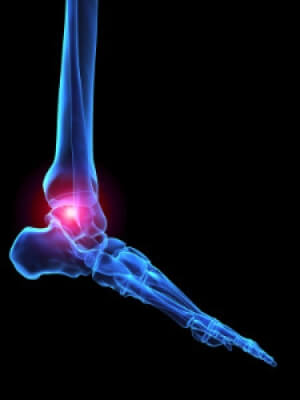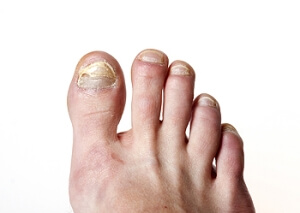
Ingrown Toenails
Ingrown toenails (onychocryptosis) are a common foot ailment and it is very unpleasant to experience. The condition is caused by an increase in pressure from the ingrowth of the nail edge into the skin of the toe. Ingrown toenails commonly cause pain in those who experience them. In some cases, the skin surrounding the ingrown toenail may break which may lead bacteria to enter through and cause an infection. Common symptoms of this ailment include pain, redness, swelling, and warmth around the toe.
An imbalance between the size of the nail and the enlargement of the nail skin edge causes ingrown toenails. This condition is often caused by improperly trimming the toenails. If you are trying you cut your nails, you should always try to trim straight across instead of in a rounded shape. Ingrown toenails can also be an inherited condition and they may also be caused by improper shoe fitting.
Another common cause of the condition is wearing shoes that are either too small or too large. Other causes include poor foot hygiene, obesity, diabetes, arthritis, edema, and fungal infections. There are many risk factors that may make a person more likely to develop an ingrown toenail. Athletes who play “stop and start” sports such as tennis, soccer, and basketball are most likely to have ingrown toenails.
People who have diabetes, a compromised immune system, or poor circulation should immediately seek care from a podiatrist if they have an ingrown toenail. It is also recommended to seek professional assistance if at-home remedies are not successful within a week or if there is persistent pain.
A Common Form of Arthritis
 The painful condition that is known as rheumatoid arthritis is considered to be one of the most common forms of arthritis. Many patients experience the first symptoms of this ailment in the feet, and these may include swelling, soreness, or pain. The noticeable signs of rheumatoid arthritis may be seen and felt in the smaller joints of the toes, or in the ankle joint. Daily activities may become difficult to accomplish as a result of the joint pain and swelling that often accompanies this condition. When this is diagnosed, mild relief may be felt when proper insoles are worn, and this may help to slow the development arthritis in the affected joints. If you notice symptoms that are indicative of rheumatoid arthritis, it is advised that you seek the counsel of a podiatrist who can offer proper treatment techniques.
The painful condition that is known as rheumatoid arthritis is considered to be one of the most common forms of arthritis. Many patients experience the first symptoms of this ailment in the feet, and these may include swelling, soreness, or pain. The noticeable signs of rheumatoid arthritis may be seen and felt in the smaller joints of the toes, or in the ankle joint. Daily activities may become difficult to accomplish as a result of the joint pain and swelling that often accompanies this condition. When this is diagnosed, mild relief may be felt when proper insoles are worn, and this may help to slow the development arthritis in the affected joints. If you notice symptoms that are indicative of rheumatoid arthritis, it is advised that you seek the counsel of a podiatrist who can offer proper treatment techniques.
Because RA affects more than just your joints, including the joints in your feet and ankles, it is important to seek early diagnosis from your podiatrist if you feel like the pain in your feet might be caused by RA. For more information, contact one of our podiatrists of Sayville Foot Care. Our doctors will assist you with all of your podiatric concerns.
What Is Rheumatoid Arthritis?
Rheumatoid Arthritis (RA) is an autoimmune disorder in which the body’s own immune system attacks the membranes surrounding the joints. Inflammation of the lining and eventually the destruction of the joint’s cartilage and bone occur, causing severe pain and immobility.
Rheumatoid Arthritis of the Feet
Although RA usually attacks multiple bones and joints throughout the entire body, almost 90 percent of cases result in pain in the foot or ankle area.
Symptoms
- Swelling and pain in the feet
- Stiffness in the feet
- Pain on the ball or sole of feet
- Joint shift and deformation
Diagnosis
Quick diagnosis of RA in the feet is important so that the podiatrist can treat the area effectively. Your doctor will ask you about your medical history, occupation, and lifestyle to determine the origin of the condition. Rheumatoid Factor tests help to determine if someone is affected by the disease.
If you have any questions please feel free to contact our office located in Sayville, NY . We offer the newest diagnostic and treatment technologies for all your foot and ankle needs.
Rheumatoid Arthritis in the Feet
Rheumatoid Arthritis is a chronic progressive disease that attacks several joints throughout the body. It is an autoimmune disease in which the body’s immune system mistakenly attacks the joints. As a result, the tissue inside the joints, called synovium, starts to thicken and causes pain around the joints. The synovium is responsible for creating a fluid that lubricates the joints to help them move. Approximately 1.5 million people in the United States have Rheumatoid Arthritis. Women are almost three times as likely to have RA compared to men, and it’s disease usually begins between the ages of 30 and 60. People who have a genetic history of RA are more likely to develop the disease.
Symptoms of RA may include the following sensations in the joints: pain, tenderness, swelling, redness, warmth, stiffness, and loss of range. Swollen joints are a very common symptom for those with the disease. At times, it may be minimal, but it may also be very apparent. Another typical symptom is joint stiffness. Doctors will often use the direction of morning stiffness to measure the severity of a patient’s joint inflammation. Other RA symptoms include limping, anemia, fever, and fatigue.
To diagnose RA, your podiatrist will typically request x-rays to see how much damage there is in the joints. Blood tests may also be performed to show if there are any signs of anemia, or antibodies such as the rheumatoid factor. If you have previously been diagnosed with RA, you should know the disease may spread to your feet and ankles.
There are many non-surgical options that can be used to treat this ailment. Some of these options include physical therapy, foot massages, orthotics, bracing, supportive shoes, and steroid injections. Physical therapy is useful because it will help stretch and strengthen the joints in both the foot and ankle to improve joint function. Massages can help improve blood circulation which will be good for the feet. Choosing proper footwear will allow you to walk with comfortability if you are a sufferer from RA. Lastly, bracing will help stabilize the foot joints, limit deformities and decrease pain.
In severe cases, surgery may be a treatment option that should be considered. For those who cannot walk without experiencing pain and those whose deformities can not be managed with braces, surgery should be considered. Your podiatrist will recommend surgery if he or she believes it will improve your foot biomechanics.
Common Foot Ailments That May Occur During Pregnancy
 One of the most common foot ailments that many pregnant women may encounter is flat feet. This condition may develop as a result of the additional weight that is typically gained during pregnancy. Mild relief may be found if proper shoes are worn, and these may include footwear that supports the arch. Pregnancy may cause ingrown toenails to develop, and it may be difficult to trim the toenails properly. Improvement may be seen when the feet are soaked in a salt-water solution, and this may help to soften the nail and surrounding areas. Additionally, pregnant women may experience swollen feet, and may feel better when the feet are elevated. Performing gentle stretching techniques throughout the day and drinking plenty of fresh water may help to reduce the swelling. If you have questions about how pregnancy may affect the feet, it is suggested that you consult with a podiatrist.
One of the most common foot ailments that many pregnant women may encounter is flat feet. This condition may develop as a result of the additional weight that is typically gained during pregnancy. Mild relief may be found if proper shoes are worn, and these may include footwear that supports the arch. Pregnancy may cause ingrown toenails to develop, and it may be difficult to trim the toenails properly. Improvement may be seen when the feet are soaked in a salt-water solution, and this may help to soften the nail and surrounding areas. Additionally, pregnant women may experience swollen feet, and may feel better when the feet are elevated. Performing gentle stretching techniques throughout the day and drinking plenty of fresh water may help to reduce the swelling. If you have questions about how pregnancy may affect the feet, it is suggested that you consult with a podiatrist.
Pregnant women with swollen feet can be treated with a variety of different methods that are readily available. For more information about other cures for swollen feet during pregnancy, consult with one of our podiatrists from Sayville Foot Care. Our doctors will attend to all of your foot and ankle needs.
What Foot Problems Can Arise During Pregnancy?
One problem that can occur is overpronation, which occurs when the arch of the foot flattens and tends to roll inward. This can cause pain and discomfort in your heels while you’re walking or even just standing up, trying to support your baby.
Another problem is edema, or swelling in the extremities. This often affects the feet during pregnancy but tends to occur in the later stages.
How Can I Keep My Feet Healthy During Pregnancy?
- Wearing orthotics can provide extra support for the feet and help distribute weight evenly
- Minimize the amount of time spent walking barefoot
- Wear shoes with good arch support
- Wear shoes that allow for good circulation to the feet
- Elevate feet if you experience swelling
- Massage your feet
- Get regular, light exercise, such as walking, to promote blood circulation to the feet
If you have any questions please feel free to contact our office located in Sayville, NY . We offer the newest diagnostic and treatment technologies for all your foot and ankle needs.
Pregnancy and Foot Health
Many pregnant women complain about foot pain while they are expecting. Foot pain can primarily be caused by weight gain and hormonal changes taking place in the body. By understanding how pregnancy impacts the health of a woman's feet, a pregnant woman can take action to keep her feet as healthy and comfortable as possible.
Because a woman's weight changes during pregnancy, more pressure is brought to bear on both the legs and the feet. This weight shift can cause two major foot problems: over-pronation, also known as flat feet, as well as edema, which is swelling of the feet. Over-pronation occurs when the arch of the foot flattens, causing the foot to roll inwards when the individual is walking, and can aggravate the plantar fascia tissues located along the bottom of the feet. If these tissues become inflamed, a pregnant woman can experience pain in the heel of the foot as well as severe foot pain while walking or standing. Swelling of the feet, or edema, often occurs in the later stages of pregnancy. It is caused by slow circulation and water retention, and may turn the feet a light purple color.
To keep feet in good health and prevent over-pronation, pregnant women should avoid walking barefoot and be sure they are wearing shoes that offer good arch support. A device known as an orthotic can be added to regular footwear in order to provide additional support for the feet during pregnancy. Any expectant mother whose feet hurt should first check to see if the shoes she is wearing are old, worn out and not offering the proper support necessary for distributing the weight of her body during pregnancy.
To treat edema of the feet, a good start is to wear quality footwear which offers support and good circulation. Keep feet elevated whenever possible by using a foot stool while seated. Stay well hydrated by drinking plenty of water to prevent water retention in the feet. Any swelling that occurs in only one foot should be examined as soon as possible by a doctor.
Good foot health during pregnancy can help expectant mothers avoid foot pain that leads to other health problems. Massaging the feet and doing regular gentle exercise like walking aids foot health by contributing to good circulation. Supportive shoes are also a good investment that will support foot health during pregnancy.
Symptoms and Possible Causes of Toenail Fungus
 There are normal levels of fungus in the body, in addition to different types of bacteria. Overgrown fungus levels may result in an infection. Onychomycosis is a fungal infection that typically affects the toenails. It generally develops gradually, and noticeable symptoms may include yellow or white toenails, or a possible loss of the nail. If medical conditions exist, they may increase the chances of developing toenail fungus. These may include diabetes, diseases that may cause poor circulation, or a weakened immune system. Additionally, if you have a nail injury, or spend time in public swimming pools or locker rooms, or wear artificial nails, you may notice signs of a toenail fungus. There may be measures that can be implemented, which may prevent this condition from developing. These may include avoiding walking barefoot in public areas, thoroughly drying your feet after showering, or utilizing antifungal sprays. If you feel you have developed a toenail fungus, it is suggested to speak to a podiatrist who can offer correct treatment options.
There are normal levels of fungus in the body, in addition to different types of bacteria. Overgrown fungus levels may result in an infection. Onychomycosis is a fungal infection that typically affects the toenails. It generally develops gradually, and noticeable symptoms may include yellow or white toenails, or a possible loss of the nail. If medical conditions exist, they may increase the chances of developing toenail fungus. These may include diabetes, diseases that may cause poor circulation, or a weakened immune system. Additionally, if you have a nail injury, or spend time in public swimming pools or locker rooms, or wear artificial nails, you may notice signs of a toenail fungus. There may be measures that can be implemented, which may prevent this condition from developing. These may include avoiding walking barefoot in public areas, thoroughly drying your feet after showering, or utilizing antifungal sprays. If you feel you have developed a toenail fungus, it is suggested to speak to a podiatrist who can offer correct treatment options.
If left untreated, toenail fungus may spread to other toenails, skin, or even fingernails. If you suspect you have toenail fungus it is important to seek treatment right away. For more information about treatment, contact one of our podiatrists of Sayville Foot Care. Our doctors can provide the care you need to keep you pain-free and on your feet.
Symptoms
- Warped or oddly shaped nails
- Yellowish nails
- Loose/separated nail
- Buildup of bits and pieces of nail fragments under the nail
- Brittle, broken, thickened nail
Treatment
If self-care strategies and over-the-counter medications does not help your fungus, your podiatrist may give you a prescription drug instead. Even if you find relief from your toenail fungus symptoms, you may experience a repeat infection in the future.
Prevention
In order to prevent getting toenail fungus in the future, you should always make sure to wash your feet with soap and water. After washing, it is important to dry your feet thoroughly especially in between the toes. When trimming your toenails, be sure to trim straight across instead of in a rounded shape. It is crucial not to cover up discolored nails with nail polish because that will prevent your nail from being able to “breathe”.
In some cases, surgical procedure may be needed to remove the toenail fungus. Consult with your podiatrist about the best treatment options for your case of toenail fungus.
If you have any questions, please feel free to contact our office located in Sayville, NY . We offer the newest diagnostic and treatment technologies for all your foot care needs.
Treating Toenail Fungus
Fungal infection of the toenail, or onychomycosis, typically appears as a gradual change in a toenail’s texture and color that involves brittleness and darkening. The fungal infection itself occurs beneath the surface of the nail. Aside from discoloration, other symptoms include the collection of debris beneath the nail plate, white marks on the nail plate, and a foul odor emanating from the nail. If ignored, the infection can spread into other nails and the skin; in severe cases, it can hinder one’s ability to work or walk.
The toenails are particularly vulnerable to contracting infection in moist environments where people are likely to be walking barefoot, such as around swimming pools, public showers, and locker rooms. Fungal infection may also be more likely to occur in nail beds that have been injured, and sufferers of chronic diseases such as diabetes, circulatory problems, or immunodeficiency conditions are particularly prone to developing fungal nails.
Fungal nails can be primarily prevented by practicing proper hygiene and regularly examining the feet and toes. Carefully washing the feet with soap and water and thoroughly drying the feet afterwards are essential. Other tips include wearing shower shoes in public areas, changing shoes and socks daily, keeping toenails clipped at a short length, wearing breathable shoes that fit properly, wearing moisture-wicking socks, and disinfecting home pedicure tools and instruments used to cut nails.
Fungal nail treatment may vary between patients and the severity of the condition. Your podiatrist may suggest a daily routine of cleansing that spans over a period of time to ease mild infections. Over-the-counter or prescription antifungal agents may also be prescribed, including topical and/or oral medications. Debridement, or the removal of diseased nail matter and debris, may also be performed. In more severe cases, surgical treatment may be needed. In some instances, the temporary removal of the fungal nail allows for the direct application of a topical antifungal to the nail bed. In other cases, a chronically painful fungal nail that has not responded to other treatments may be permanently removed; this allows the infection to be cured and avoids the growth of a deformed nail.
Podiatry as a Career
 The definition of a podiatrist is a doctor who specializes in treating conditions and disorders of the feet and lower extremities. A typical day may consist of conferring with patients about specific foot conditions, or to offer custom-made orthotics, which may help in the treatment of certain foot deformities. Additionally, a podiatrist may use effective techniques to treat heel spurs, ingrown toenails, corns, or bunions. There are several places a podiatrist can pursue this type of medicine. These may include a group or private practice, extended care facilities, or hospitals. Podiatrists may also be found practicing medicine in the armed forces and may work for municipal health departments. If you are considering a career in podiatry, it is suggested that you speak to a podiatrist who can answer any questions you may have.
The definition of a podiatrist is a doctor who specializes in treating conditions and disorders of the feet and lower extremities. A typical day may consist of conferring with patients about specific foot conditions, or to offer custom-made orthotics, which may help in the treatment of certain foot deformities. Additionally, a podiatrist may use effective techniques to treat heel spurs, ingrown toenails, corns, or bunions. There are several places a podiatrist can pursue this type of medicine. These may include a group or private practice, extended care facilities, or hospitals. Podiatrists may also be found practicing medicine in the armed forces and may work for municipal health departments. If you are considering a career in podiatry, it is suggested that you speak to a podiatrist who can answer any questions you may have.
If you are experiencing pain in the feet or ankles, don’t join the stubborn majority refusing treatment. Feel free to contact one of our podiatrists from Sayville Foot Care. Our doctors can provide the care you need to keep you pain-free and on your feet.
What Is a Podiatrist?
Someone would seek the care of a podiatrist if they have suffered a foot injury or have common foot ailments such as heal spurs, bunions, arch problems, deformities, ingrown toenails, corns, foot and ankle problems, etc.
Podiatric Treatment
A podiatrist will treat the problematic areas of the feet, ankle or lower leg by prescribing the following:
- Physical therapy
- Drugs
- Orthotic inserts or soles
- Surgery on lower extremity fractures
A common podiatric procedure a podiatrist will use is a scanner or force plate which will allow the podiatrist to know the designs of orthotics. Patients are then told to follow a series of tasks to complete the treatment. The computer will scan the foot a see which areas show weight distribution and pressure points. The podiatrist will read the analysis and then determine which treatment plans are available.
If you have any questions please feel free to contact our office located in Sayville, NY . We offer the newest diagnostic and treatment technologies for all your foot and ankle needs.
What is a Podiatrist?
A podiatrist is a Doctor of Podiatric Medicine who treats the foot, ankle, and related structures of the leg. If you are having any pain, injuries, or abnormalities in these areas, it is best that you seek help from a podiatrist.
Podiatrists complete four years of training in a podiatric medical school. Their training is like that of other physicians, and they may go on to complete a fellowship training after a residency training. Some podiatrists are board certified meaning they have advanced training, clinical experience, and have taken an exam to prove their skills. Certifying boards for podiatry are the American Board of Foot and Ankle Surgery and the American Board of Podiatric Medicine. Podiatrists may work in private practices, hospitals, clinics, or they may even become professors at colleges of podiatric medicine.
While in college, those who want to be podiatrists often take biology, chemistry, and physics classes in preparation for podiatry school. In podiatry school, students study how the bones, nerves, and muscles work together to help you move around. Additionally, they study injuries and how to properly diagnose and treat them. Admittance into podiatric medical school requires the completion of 90 semester hours of undergraduate study with a good grade point average, and acceptable scores on the MCAT (Medical College Admission Test)
Podiatrists treat many different conditions such as: aching feet, ankle pain, bunions, corns, hammertoes, fungus, ingrown toenails, plantar fasciitis, sprains and more. Common forms of treatment for these conditions are physical therapy, drugs, or surgery. Podiatrists may also recommend corrective shoe inserts, custom-made shoes, plaster casts, and strappings to correct deformities.
Even if you are someone whose feet are in generally good condition, you should still visit a podiatrist to have your feet properly exfoliated and maintained, or to make sure you are looking after your feet properly.
Foot Surgery May Bring Relief
Many patients have foot conditions that may benefit from having foot surgery performed. This is often recommended if traditional treatment has been unsuccessful, and may be considered to find relief. Fusion surgery may help patients who have arthritis in the foot or ankle. The purpose of having this type of surgery performed is to eliminate pain and discomfort by fusing the bones together. Patients who have chronic heel pain may benefit from having heel surgery performed. This may be an option for people who are afflicted with plantar fasciitis. If you are feeling numbness or a tingling sensation in your toes, neuroma surgery may be a choice to consider. This is performed by removing a small part of the nerve, which may bring relief. If you have foot pain and are thinking about having surgery performed, it is suggested to speak with a podiatrist who can properly guide you in determining if this is right for you.
Foot surgery is sometimes necessary to treat a foot ailment. To learn more, contact one of our podiatrists of Sayville Foot Care. Our doctors will assist you with all of your foot and ankle needs.
When Is Surgery Necessary?
Foot and ankle surgery is generally reserved for cases in which less invasive, conservative procedures have failed to alleviate the problem. Some of the cases in which surgery may be necessary include:
- Removing foot deformities like bunions and bone spurs
- Severe arthritis that has caused bone issues
- Cosmetic reconstruction
What Types of Surgery Are There?
The type of surgery you receive will depend on the nature of the problem you have. Some of the possible surgeries include:
- Bunionectomy for painful bunions
- Surgical fusion for realignment of bones
- Neuropathy decompression surgery to treat nerve damage
Benefits of Surgery
Although surgery is usually a last resort, it can provide more complete pain relief compared to non-surgical methods and may allow you to finally resume full activity.
Surgical techniques have also become increasingly sophisticated. Techniques like endoscopic surgery allow for smaller incisions and faster recovery times.
If you have any questions please feel free to contact our office located in Sayville, NY . We offer the newest diagnostic and treatment technologies for all your foot and ankle needs.






